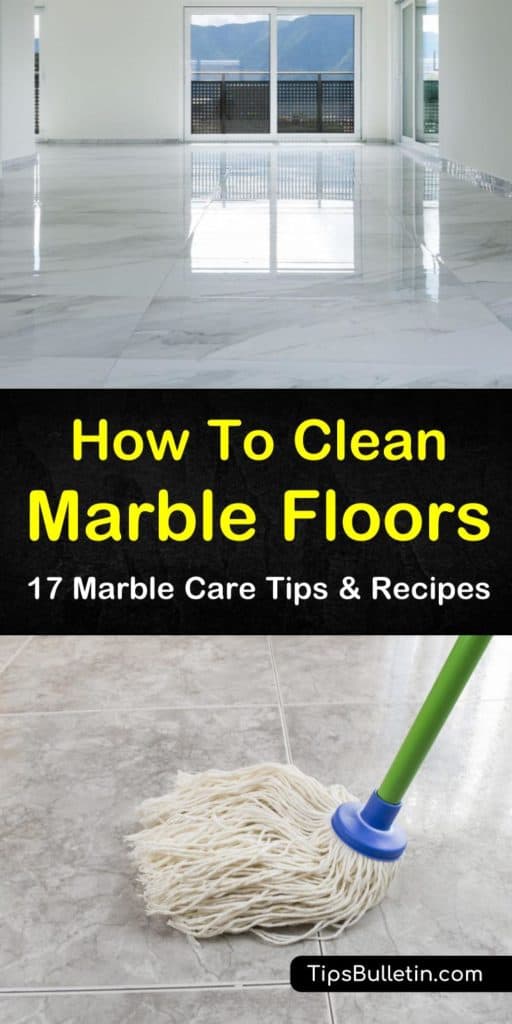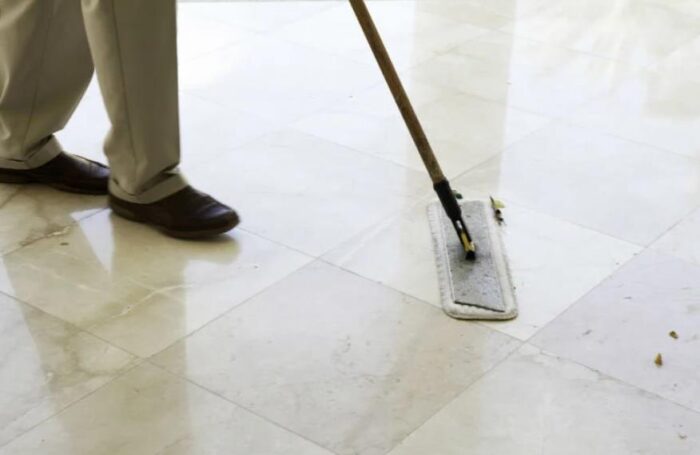Marble floors are a luxurious and elegant addition to any home, offering a timeless beauty that can elevate the aesthetic of your space. However, maintaining their pristine appearance requires careful daily cleaning and care. Here’s a detailed guide on how to clean marble floors daily, ensuring they remain stunning and durable for years to come.
Understanding Your Marble Floor
Marble is a metamorphic rock composed primarily of calcite, a mineral that gives it its distinctive, natural veining, and smooth surface. Unlike other types of flooring, marble is porous and susceptible to staining and etching from acidic substances. Understanding these characteristics is crucial for effective cleaning.
Marble floors come in various finishes, such as polished, honed, and tumbled. Each finish has its care requirements. Polished marble, with its glossy surface, is more susceptible to scratches, while honed marble has a matte finish that can hide minor imperfections but still requires diligent care to avoid staining.
It’s also important to recognize that marble can react adversely to certain cleaning products. Acidic cleaners, such as vinegar or lemon juice, can etch the surface, causing dull spots. Alkaline cleaners can leave residues that dull the shine. Therefore, using pH-neutral cleaners specifically designed for marble is essential.
Understanding these aspects of your marble floor will help you make informed decisions about daily cleaning routines and product choices, ensuring the longevity and beauty of your investment.

Essential Tools and Materials
Keeping marble floors clean on a daily basis requires a few essential tools and materials. Here’s a list of what you’ll need:
- Soft Microfiber Mop: Ideal for daily dusting and cleaning without scratching the surface.
- pH-Neutral Marble Cleaner: A cleaner specifically designed for marble, ensuring it doesn’t harm the surface.
- Warm Water: For diluting the marble cleaner and wiping the floor.
- Soft Cloths or Sponges: For spot cleaning and wiping up spills.
- Vacuum Cleaner with Soft Brush Attachment: For removing dirt and debris without scratching the floor.
- Marble Sealant: For periodic application to protect the marble from stains and spills.
These tools and materials are essential for maintaining the cleanliness and integrity of your marble floors. Investing in high-quality products will ensure you can keep your floors looking their best with minimal effort.
Daily Cleaning Routine
Maintaining a daily cleaning routine is vital to keep marble floors in top condition. Here’s a step-by-step guide to an effective daily cleaning routine:
Dust Mopping: Begin each day by dust mopping your marble floors with a soft microfiber mop. This will remove loose dirt, dust, and debris that can scratch the surface over time. Avoid using a traditional broom, as the bristles can be too harsh on the marble.
Spot Cleaning Spills: Marble is prone to staining, so it’s crucial to clean up spills immediately. Use a soft cloth or sponge dampened with warm water and a few drops of pH-neutral marble cleaner to gently blot the spill. Avoid rubbing, as this can spread the stain.
Damp Mopping: After dust mopping, use a damp microfiber mop to clean the floor. Mix warm water with a small amount of pH-neutral marble cleaner, following the manufacturer’s instructions. Mop the floor using a figure-eight motion to cover all areas evenly.
Drying the Floor: After damp mopping, dry the floor with a clean, soft cloth to prevent water spots and streaks. This step is essential to maintain the marble’s shine and prevent moisture from seeping into the porous surface.
Inspecting for Stains: Daily inspection of your marble floors will help you catch stains or etching early. If you notice any, address them promptly using appropriate marble-safe stain removers.
Maintaining High-Traffic Areas: Pay extra attention to high-traffic areas, as these zones accumulate more dirt and wear. Consider placing rugs or mats in these areas to reduce the amount of dirt that comes into contact with the marble.
Stain Removal Techniques
Even with diligent daily cleaning, marble floors can still be susceptible to stains. Knowing how to address these stains promptly and effectively is crucial. Here are some common types of stains and how to remove them:
Organic Stains (Food, Drinks): For organic stains such as coffee, tea, or fruit juice, use a solution of 12% hydrogen peroxide mixed with a few drops of ammonia. Apply the solution to the stain with a soft cloth, and let it sit for a few minutes before wiping it away.
Oil-Based Stains (Grease, Cosmetics): For oil-based stains, apply a mixture of baking soda and water to create a paste. Spread the paste over the stain, cover it with plastic wrap, and let it sit for 24 hours. The baking soda will draw out the oil from the marble.
Rust Stains: Rust stains can be challenging to remove. Use a poultice made from a non-acidic rust remover and a marble-safe powder (such as diatomaceous earth) mixed with water to form a thick paste. Apply the poultice to the stain, cover it, and let it sit until dry before removing.
Water Spots: Water spots and rings can be removed by gently buffing the area with dry 0000 steel wool. For tougher spots, use a marble polishing powder and follow the manufacturer’s instructions.
Etch Marks: Etch marks from acidic substances can be treated with a marble polishing powder. Apply the powder with a damp cloth and rub it into the etch mark using small, circular motions. Buff the area with a clean cloth to restore the shine.
Ink and Paint Stains: For ink or paint stains, use a mixture of acetone or lacquer thinner and a marble-safe powder to form a poultice. Apply the poultice to the stain, cover it, and let it sit until dry before removing.
Preventive Measures
Taking preventive measures can significantly reduce the amount of cleaning and maintenance required for marble floors. Here are some tips to help protect your marble:
Use Rugs and Mats: Place rugs and mats in high-traffic areas, such as entryways and hallways, to catch dirt and debris before it reaches the marble floor. Choose non-slip mats to prevent accidents.
Felt Pads for Furniture: Attach felt pads to the bottom of furniture legs to prevent scratches and gouges when moving furniture. Regularly check and replace the pads as needed.
Remove Shoes: Encourage family members and guests to remove their shoes before walking on marble floors. Shoes can carry dirt, grit, and abrasive particles that can scratch the marble surface.
Clean Spills Immediately: Promptly clean up any spills to prevent staining. Keep soft cloths or sponges handy for quick blotting, and follow up with a marble-safe cleaner if necessary.
Regular Sealing: Periodically seal your marble floors to protect against stains and etching. Follow the manufacturer’s recommendations for the frequency of sealing, which can vary depending on the type of marble and the level of use.
Avoid Harsh Cleaners: Use only pH-neutral cleaners specifically designed for marble. Avoid acidic or alkaline cleaners, as well as abrasive scrubbing pads, which can damage the marble surface.
Periodic Deep Cleaning
In addition to daily cleaning, periodic deep cleaning is essential to maintain the luster and integrity of marble floors. Here’s a step-by-step guide to deep cleaning your marble floors:
Vacuuming: Start by thoroughly vacuuming the floor with a vacuum cleaner equipped with a soft brush attachment. This will remove any loose dirt and debris that could scratch the marble during the deep cleaning process.
Preparing the Cleaning Solution: Mix a pH-neutral marble cleaner with warm water according to the manufacturer’s instructions. Avoid using hot water, as it can damage the marble.
Damp Mopping: Dip a microfiber mop into the cleaning solution and wring it out thoroughly. Mop the floor in sections, using a figure-eight motion to ensure even coverage. Avoid soaking the floor with excessive water.
Rinsing the Mop: Regularly rinse and wring out the mop to prevent spreading dirt around. Change the cleaning solution as needed to ensure it remains effective.
Drying the Floor: After mopping, dry the floor with a clean, soft cloth to prevent water spots and streaks. This step is crucial for maintaining the marble’s shine and preventing moisture from seeping into the porous surface.
Polishing: For extra shine, use a marble polishing powder following the manufacturer’s instructions. Apply the powder with a damp cloth, buff it into the floor using circular motions, and then wipe it away with a clean, dry cloth.
Common Mistakes to Avoid
Cleaning marble floors requires careful attention to avoid damaging the delicate surface. Here are some common mistakes to avoid:
Using Acidic or Alkaline Cleaners: Avoid using vinegar, lemon juice, or other acidic cleaners, as well as strong alkaline cleaners. These can etch and dull the marble surface.
Using Abrasive Scrubbing Pads: Never use abrasive scrubbing pads or brushes, as they can scratch the marble. Stick to soft microfiber cloths and mops.
Allowing Spills to Sit: Don’t leave spills to sit on the marble surface, as they can penetrate and stain the porous material. Clean spills immediately to prevent damage.
Using Too Much Water: Avoid soaking the floor with excessive water during cleaning. Marble is porous and can absorb water, leading to stains and potential damage.
Skipping Sealing: Don’t neglect to seal your marble floors periodically. Sealing provides a protective barrier against stains and etching.
Ignoring Maintenance: Regular maintenance is crucial. Don’t wait until your marble floors are visibly dirty or stained. Daily and periodic cleaning is essential to keep them looking their best.
How often should I clean my marble floors?
Daily dust mopping and spot cleaning are recommended to keep marble floors free of dirt and debris. Additionally, damp mop the floors with a pH-neutral cleaner at least once a week to maintain their shine and cleanliness.
Can I use vinegar to clean marble floors?
No, vinegar is acidic and can etch the marble surface, causing dull spots and damage. Always use a pH-neutral cleaner specifically designed for marble.
How can I prevent my marble floors from getting scratched?
Use soft microfiber mops for cleaning, place rugs and mats in high-traffic areas, and attach felt pads to furniture legs. Encourage family members and guests to remove their shoes before walking on marble floors.
What should I do if my marble floor gets stained?
Address stains promptly using appropriate marble-safe stain removal techniques. For organic stains, use hydrogen peroxide with ammonia; for oil-based stains, use a baking soda paste. Consult a professional for tough stains.
How often should I seal my marble floors?
The frequency of sealing depends on the type of marble and the level of use. Generally, sealing should be done every 6 to 12 months. Follow the manufacturer’s recommendations for best results.
Can I use a steam mop on marble floors?
It’s not recommended to use a steam mop on marble floors. The high heat and moisture can damage the marble. Stick to using a damp microfiber mop with a pH-neutral cleaner for safe cleaning.
How to Clean Marble Floors Use Natural Stone Cleaning Marble
Related Posts:







